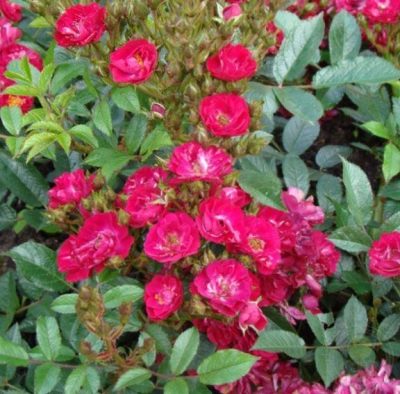
- Authors: De Ruiter
- Name synonyms: Alberich
- Breeding year: 1954
- Group: miniature (dwarf, border), polyant
- The main color of the flower: red
- Flower shape: cupped
- Flower size: small
- Diameter, cm: 3-4
- Flower type by number of petals: semi-double
- Scent: fruity
Rose Alberich is a popular variety in many regions of the country that attracts gardeners with its small and bright buds, as well as resistance to harsh conditions. It is worth considering in more detail the characteristics and characteristics of the culture.
Breeding history of the variety
The Alberich variety was bred by breeders from the Netherlands in 1954. The flower belongs to the group of miniature or polyanthus roses, suitable for growing in containers in the garden or at home.
Description of the variety
Alberich is a small bush that features bright buds.
Plant characteristics:
- bush height - up to 35 cm;
- compact form;
- leaf plates are dark green and small in size;
- the diameter of the buds is 3-4 cm;
- cupped shape of flowers.
Rose petals are painted in a deep red-cherry color, exude a faint fruity aroma. Due to the small size of the buds on one stem, it grows up to 5-10 flowers, if you correctly approach the cultivation of the crop.
Advantages and disadvantages
The pluses of Alberich include:
- bright buds;
- unpretentious care;
- frost resistance;
- compact size.
The rose grows well both in sunny and shaded areas. The variety will adorn any garden, attracting attention with long flowering. Among the shortcomings, there is a weak resistance to rain, which can cause flower rot.
Flowering features
This rose blooms profusely throughout the season. Her flowering is not interrupted, the main thing is to remove faded inflorescences.
Use in landscape design
Rose Alberich is easy to plant, therefore it is often used in landscape design. The variety will look perfect in group plantings, complementing and completing any composition. Small buds, characteristic of the Alberich rose, will act as a bright accent and attract the attention of others.
Landing
Roses are planted by cuttings. Before planting, the material should be prepared by germinating the root system and hardening the plant. It is also worth taking care of choosing a landing site.
Recommendations:
- the site must be sunny and calm;
- the pH level should be neutral;
- groundwater should be located deep.
If the site is located in a lowland, it is worthwhile to provide a drainage system. Also, with high acidity, you should take care of the introduction of alkaline fertilizers, which will act as a neutralizer.
Before planting, it is additionally recommended to thoroughly loosen the soil in order to saturate the soil with oxygen and improve the survival rate of the cuttings. The planting is carried out so that there are 6-8 cuttings per 1 m2 of flower beds. The depth of the planting pit should be such that the root system is completely hidden and it can be covered with earth.
Growing and care
When the rose is planted, it remains to take care of the care of the plant. The key advantage of the Alberich variety is ease of maintenance, however, following a number of recommendations of experienced gardeners will allow you to achieve long flowering and bright buds.
- Watering. The rose is undemanding to watering. On average, it is recommended to add water to the soil once every 3-4 days, taking into account the weather and climatic conditions of the region. You should also pay attention to the place where the bush grows.If the site is shaded, it is worth taking care of drainage and reducing watering so that moisture does not stagnate and does not lead to rotting of the bushes.
- Top dressing. On average, roses are fed 2-3 times per season. The first time fertilizers are applied during the period of active growth, a week or two after planting the cuttings. Organic compounds are usually used as top dressing. Further, it is recommended to fertilize the soil during the flowering period and in the fall to prepare the bushes for frost. Here, preference should be given to mineral complexes.
- Loosening and weeding. Two mandatory procedures that should be started after each watering. With the help of loosening and weeding, it will be possible to prevent attacks of diseases and insects, as well as accelerate the flow of nutrients to the plant bushes.
- Pruning. The plant needs constant pruning. For the first year, gardeners are advised to prune the bushes for tillering in order to develop a shoot system. Then pruning should be done for prophylaxis to prevent the spread of diseases and pests. It is also worth cutting off the faded buds so that the rose does not waste energy on the formation of seeds, but continues to bloom.
Frost resistance and preparation for winter
The variety is highly resistant to low temperatures and does not require additional shelter, even in regions with severe winters. Therefore, it is not necessary to especially prepare the bushes for frost. However, gardeners recommend covering the plant with a layer of mulch to protect the root system from freezing.
Diseases and pests
Alberich pleases with strong immunity and is rarely exposed to pests or diseases. But this does not apply to powdery mildew and black spot. As a preventive measure, it is recommended to harden the cuttings before planting, as well as spray the bushes during the growth and formation of buds. Special formulations to strengthen the immunity of roses can be bought at gardening stores.
Review overview
Gardeners speak about the Alberich variety mainly in a positive way. The bush is in demand among landscape designers who note the possibility of creating unique and variegated compositions with its help to decorate gardens of all sizes.































































